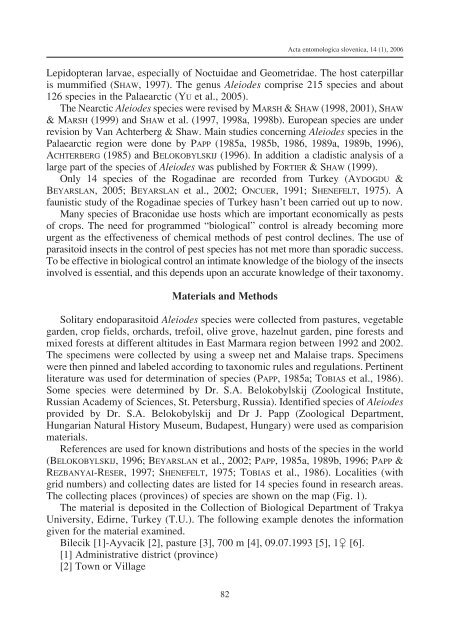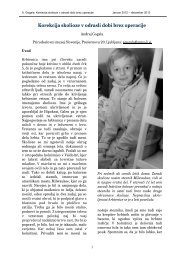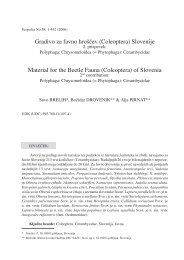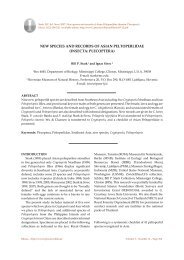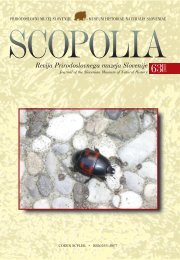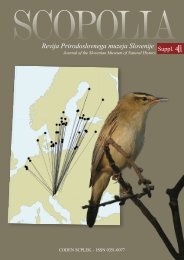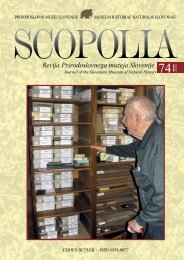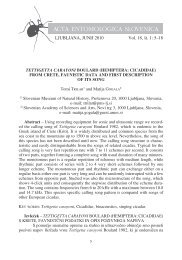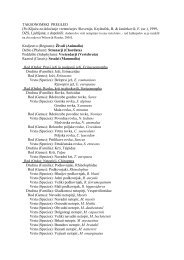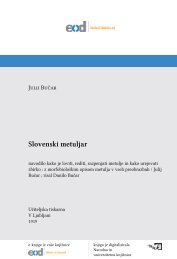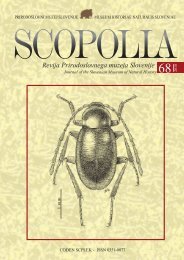Acta entomologica slovenica, 14 (1), 2006Lepidopteran larvae, especially of Noctuidae and Geometridae. The host caterpillaris mummified (SHAW, 1997). The genus Aleiodes comprise 215 species and about126 species in the Palaearctic (YU et al., 2005).The Nearctic Aleiodes species were revised by MARSH & SHAW (1998, 2001), SHAW& MARSH (1999) and SHAW et al. (1997, 1998a, 1998b). European species are underrevision by Van Achterberg & Shaw. Main studies concerning Aleiodes species in thePalaearctic region were done by PAPP (1985a, 1985b, 1986, 1989a, 1989b, 1996),ACHTERBERG (1985) and BELOKOBYLSKIJ (1996). In addition a cladistic analysis of alarge part of the species of Aleiodes was published by FORTIER & SHAW (1999).Only 14 species of the Rogadinae are recorded from Turkey (AYDOGDU &BEYARSLAN, 2005; BEYARSLAN et al., 2002; ONCUER, 1991; SHENEFELT, 1975). Afaunistic study of the Rogadinae species of Turkey hasn’t been carried out up to now.Many species of Braconidae use hosts which are important economically as pestsof crops. The need for programmed “biological” control is already becoming moreurgent as the effectiveness of chemical methods of pest control declines. The use ofparasitoid insects in the control of pest species has not met more than sporadic success.To be effective in biological control an intimate knowledge of the biology of the insectsinvolved is essential, and this depends upon an accurate knowledge of their taxonomy.Materials and MethodsSolitary endoparasitoid Aleiodes species were collected from pastures, vegetablegarden, crop fields, orchards, trefoil, olive grove, hazelnut garden, pine forests andmixed forests at different altitudes in East Marmara region between 1992 and 2002.The specimens were collected by using a sweep net and Malaise traps. Specimenswere then pinned and labeled according to taxonomic rules and regulations. Pertinentliterature was used for determination of species (PAPP, 1985a; TOBIAS et al., 1986).Some species were determined by Dr. S.A. Belokobylskij (Zoological Institute,Russian Academy of Sciences, St. Petersburg, Russia). Identified species of Aleiodesprovided by Dr. S.A. Belokobylskij and Dr J. Papp (Zoological Department,Hungarian Natural History Museum, Budapest, Hungary) were used as comparisionmaterials.References are used for known distributions and hosts of the species in the world(BELOKOBYLSKIJ, 1996; BEYARSLAN et al., 2002; PAPP, 1985a, 1989b, 1996; PAPP &REZBANYAI-RESER, 1997; SHENEFELT, 1975; TOBIAS et al., 1986). Localities (withgrid numbers) and collecting dates are listed for 14 species found in research areas.The collecting places (provinces) of species are shown on the map (Fig. 1).The material is deposited in the Collection of Biological Department of TrakyaUniversity, Edirne, Turkey (T.U.). The following example denotes the informationgiven for the material examined.Bilecik [1]-Ayvacik [2], pasture [3], 700 m [4], 09.07.1993 [5], 1≈ [6].[1] Administrative district (province)[2] Town or Village82
M Aydogdu, A. Beyarslan: First records of Aleiodes Wesmael, 1838 species in East Marmara region of Turkey[3] Habitat[4] Altitude[5] Colecting data (day/month/year)[6] Number of specimensFig. 1: Collecting places (provinces) of Aleiodes species in the East MarmaraRegion: 1 – Canakkale, 2 – Balikesir, 3 – Bursa, 4 – Yalova, 5 – Bilecik, 6 –Adapazari, 7 – Izmit.ResultsIn the present survey fifteen taxa of Lepidoptera endoparasitoids were found in theEast Marmara region of Turkey, which has not yet been exposed to massive applicationsof pesticides. By adding these new records, the number of Aleiodes species in Turkey hasbeen raised from 14 to 18.Aleiodes Wesmael, 1838Aleiodes apicalis (Brullé, 1832)Material examined: Adapazari-Emirdag-Mezarlik, orchard, 150 m, 21.09.1992, 2≈;Karasu, pasture, 65 m, 8.07.1993, 1≈; Balikesir-Burhaniye, orchard, 400 m, 18.09.1992,1≈; Ivrindi-Gungormez, crop field, 150 m, 17.09.1992, 1≈; Yakupkoy, pasture, 75 m,14.07.1993, 1≈; Susurluk-Aksu, orchard, 420 m, 18.09.1992, 2≈, 1∆; Bilecik-Cukurpinar, pasture, 500 m, 09.07.1993, 1≈; Tascilar-Kizilcukur, trefoil, 450 m,20.09.1992, 1≈; Osmaneli-Içmeler, mixed forests, 600 m, 09.07.1993, 1∆; Pazaryeri,crop field, 700 m, 18.08.1994, 1∆; Bursa- Incirli-Akcagac, pasture, 400 m, 20.09.1992,2≈; Inegöl-Mezitli, pine forests, 1200 m, 17.07.1993, 2≈, 1∆; Karacabey-Kulakpinari,crop field, 50 m, 12.07.1993, 1≈; Suleymaniye, pasture, 450 m, 19.09.1992, 1∆;Uludag-Yesiltarla, pine forests, 450 m, 19.09.1992, 2∆.83
- Page 1:
Vsebina / ContentsL. SENŒIŒ: Inte
- Page 4:
ISSN 1318-1998CODEN: AESLFMUDC (UDK
- Page 7 and 8:
ACTA ENTOMOLOGICA SLOVENICALJUBLJAN
- Page 9 and 10:
Leon Senœiœ: Intensity of wing pi
- Page 11 and 12:
Leon Senœiœ: Intensity of wing pi
- Page 13 and 14:
ACTA ENTOMOLOGICA SLOVENICALJUBLJAN
- Page 17 and 18:
Gabrijel Seljak: An overview of the
- Page 19 and 20:
Gabrijel Seljak: An overview of the
- Page 21 and 22:
Gabrijel Seljak: An overview of the
- Page 23 and 24:
Gabrijel Seljak: An overview of the
- Page 25 and 26:
Gabrijel Seljak: An overview of the
- Page 27 and 28:
Gabrijel Seljak: An overview of the
- Page 29 and 30:
Gabrijel Seljak: An overview of the
- Page 31 and 32:
Gabrijel Seljak: An overview of the
- Page 33 and 34: Gabrijel Seljak: An overview of the
- Page 35 and 36: Gabrijel Seljak: An overview of the
- Page 37 and 38: ACTA ENTOMOLOGICA SLOVENICALJUBLJAN
- Page 39 and 40: Bojan Kofler: Anophthalmus miroslav
- Page 41 and 42: Bojan Kofler: Anophthalmus miroslav
- Page 43 and 44: Bojan Kofler: Anophthalmus miroslav
- Page 45 and 46: ACTA ENTOMOLOGICA SLOVENICALJUBLJAN
- Page 47 and 48: Tone Lesar, Matjaæ Jeæ: Prispevek
- Page 49 and 50: Tone Lesar, Matjaæ Jeæ: Prispevek
- Page 51 and 52: Tone Lesar, Matjaæ Jeæ: Prispevek
- Page 53 and 54: Tone Lesar, Matjaæ Jeæ: Prispevek
- Page 55 and 56: Tone Lesar, Matjaæ Jeæ: Prispevek
- Page 57 and 58: ACTA ENTOMOLOGICA SLOVENICALJUBLJAN
- Page 59 and 60: Ivana Æiviå, Zoran Markoviå, Mil
- Page 61 and 62: Ivana Æiviå, Zoran Markoviå, Mil
- Page 63 and 64: Ivana Æiviå, Zoran Markoviå, Mil
- Page 65 and 66: Ivana Æiviå, Zoran Markoviå, Mil
- Page 67 and 68: Ivana Æiviå, Zoran Markoviå, Mil
- Page 69 and 70: Ivana Æiviå, Zoran Markoviå, Mil
- Page 71 and 72: ACTA ENTOMOLOGICA SLOVENICALJUBLJAN
- Page 73 and 74: Ljiljana Protiå: Nabidae (Heteropt
- Page 75 and 76: Ljiljana Protiå: Nabidae (Heteropt
- Page 77 and 78: Ljiljana Protiå: Nabidae (Heteropt
- Page 79 and 80: Ljiljana Protiå: Nabidae (Heteropt
- Page 81 and 82: Ljiljana Protiå: Nabidae (Heteropt
- Page 83: ACTA ENTOMOLOGICA SLOVENICALJUBLJAN
- Page 87 and 88: M Aydogdu, A. Beyarslan: First reco
- Page 89 and 90: M Aydogdu, A. Beyarslan: First reco
- Page 91 and 92: ACTA ENTOMOLOGICA SLOVENICALJUBLJAN
- Page 93 and 94: Emine Demir: Preliminary report on
- Page 95 and 96: Emine Demir: Preliminary report on
- Page 97 and 98: Emine Demir: Preliminary report on
- Page 99 and 100: Emine Demir: Preliminary report on
- Page 101 and 102: Emine Demir: Preliminary report on
- Page 103 and 104: Emine Demir: Preliminary report on
- Page 105 and 106: Favnistiœni zapiski / Faunistical
- Page 107 and 108: Abdullah Hasbenli, Fatma Bayrakdar,
- Page 109 and 110: Vabilo na Prvi slovenski entomoloø


